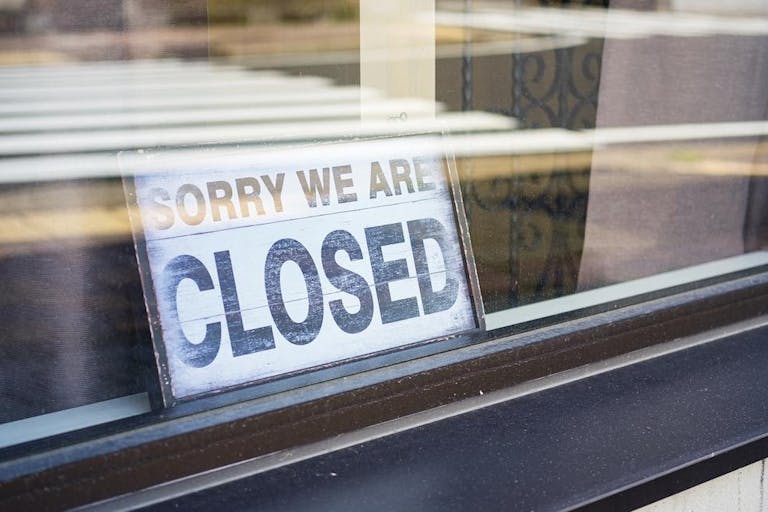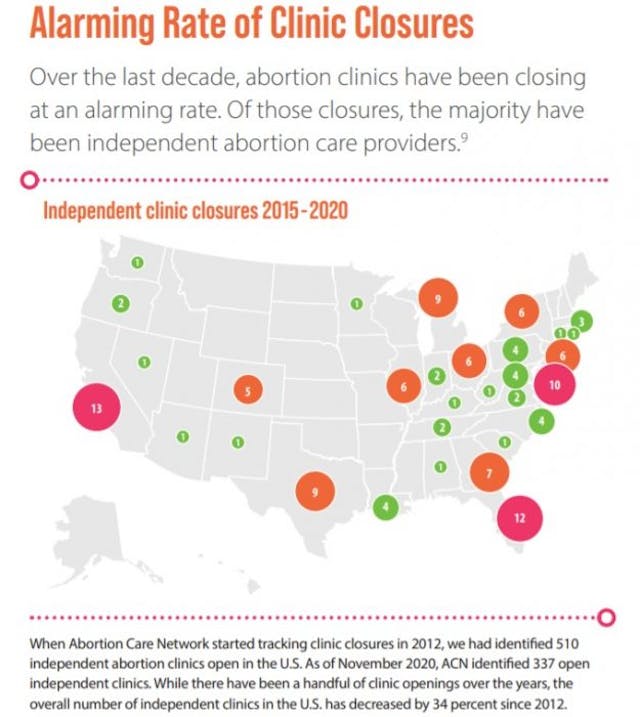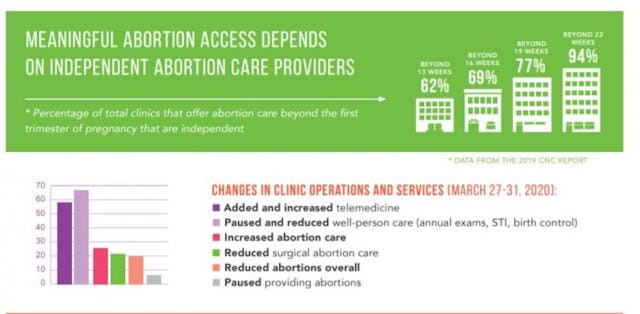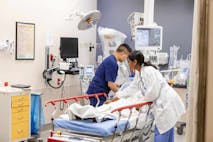
Fact Check: Woman says she was denied treatment as baby 'poisoned her from inside out'
Nancy Flanders
·
Report: In under a decade, one-third of independent abortion facilities have shut down
A new report from the Abortion Care Network (ACN) shows that since 2012, over one-third of independent abortion facilities (IACs) in the US have shut down. More than 100 have closed since 2015 and 41 closed in the past two years alone.
The ACN is a national organization which claims to represent independent abortion providers and allies. The organization’s report claimed that despite a handful of independent abortion facility openings, there has been a decline of nearly 34% of IACs within just the past eight years, down from 510 in 2012 to 337 as of November 2020.
Other reports have shown that overall, abortion numbers have been on a steady decline for years. The Centers for Disease Control and Prevention’s (CDC) most recent report revealed abortions have dropped nearly 57% to 619,591 in 2018 from a peak of 1,429,247 abortions in 1990. Guttmacher’s latest data on abortion also showed the abortion rate hit its lowest point since Roe v. Wade legalized abortion nationwide.

According to ACN, while independent abortion facilities make up about 25% of abortion facilities in the United States, they commit the majority of abortions (58%, or three out of every five abortion clients).
ACN only tracks independent abortion facilities and does not include Planned Parenthood, the largest single provider of abortions in the nation, in its reporting. But Planned Parenthood is taking advantage of those independent facility closures by gobbling up more of the market share. Despite the significant decrease in abortion numbers nationally, Planned Parenthood has steadily increased its market share from roughly 35% in 2014 to nearly 39% (38.5%) in 2017 while committing 345,672 abortions in 2018 alone.
The ACN report claimed that 80% of IACs offered both surgical and chemical abortions while just 48% of Planned Parenthood affiliated facilities provide both.
To accumulate its data, ACN claims that from August through November 2, 2020, it used “publicly available search engines and clinic directories” to collect data on every abortion facility in the United States which makes abortion services “publicly available or otherwise discloses that they provide abortion care.” ACN claims, “each independent clinic is contacted annually for operational status and information on the scope of services provided.”
Since 2015, ACN identified 127 IAC closures, as follows:
34 closed in 2015
22 closed in 2016
17 closed i n 2017
13 closed in 2018
27 closed in 2019
14 closed in 2020 (as of November).
“Over the last two years, 41 independent clinics have been forced to close in the United States. Of those clinics, 76 percent provided care after the first trimester,” the ACN report states.
Later abortions
As of November 2020, ACN reported that 62% of facilities that provided abortion after the first trimester were independent abortion clinics. Of those facilities that committed abortions later in pregnancy, IACs represented:
66% of all facilities committing abortion beyond 16 weeks.
71% of clinics committing abortion beyond 19 weeks.
81% of those committing abortion after 22 weeks.
The numbers represent a decline from what ACN reported in 2019, as seen in the image below:

Notably, the chart above from shows that in 2019, nearly 70% of abortion facilities paused/reduced “well-person care (annual exams, STI, birth control)” and nearly 60% “added and increased telemedicine” abortion. In other words, they made abortion more of their focus — well before the COVID-19 pandemic.
The decline in abortion facilities has been occurring over many years, due in part to pro-life legislation and practical efforts to help women experiencing unplanned pregnancies.
In 2017, Guttmacher reported that 89% of U.S. counties had no abortion facilities. ACN’s 2020 report found that five states have only one abortion clinic remaining.
Impact of COVID Pandemic
More recently, there seems to be an indication that the economic strain brought on by the COVID-19 pandemic may also be financially impacting abortion businesses.
Live Action News previously reported on a public webinar in which Michigan abortionist Jen Villavicencio claimed multiple abortion businesses in her state had reduced their hours or closed during the pandemic. Alice Mark, Medical Director for National Abortion Federation (NAF) admitted that some “independent” abortion facilities were functioning on little margin and “working on a shoestring,” which she said was making it “extremely difficult for those clinics to weather those storms.” Mark continued by explaining how abortion facilities “often depend on traveling providers. So COVID-19 specifically has been hugely impactful for them because they might have an older physician who is worried about their own risk… or there’s travel restrictions in place….”
This sentiment was echoed by Yashica Robinson, medical director at the Huntsville-based Alabama Women’s Center for Reproductive Alternatives. She told Time COVID-19 has negatively impacted the finances of her facility “tremendously,” noting that she had to cancel at least one week of appointments earlier this spring due to pandemic-related regulations. According to Time, while many businesses were shut down nationwide, “11 states temporarily suspended abortion services this spring, amid the growing pandemic.”
READ: The truth behind Planned Parenthood’s abortion marketshare
Abortion chain Whole Woman’s Health was also impacted, writes Time:
Whole Woman’s Health has seen several of its abortion clinics move from regular business hours to providing services 12 hours a day, split between two staff shifts, according to Marva Sadler, the group’s director of clinical services. Travel restrictions were posing difficulties for Whole Woman’s Health doctors in Texas, many of whom usually travel to provide abortions, so one doctor temporarily relocated from California to McAllen, Texas, to keep that clinic running this year.
When Texas temporarily banned abortions during its initial coronavirus order this spring, Whole Woman’s Health also spent time and money helping patients fly to abortion clinics in other states.
“As these costs have spiked, revenues have plummeted,” Time wrote.
In March 2020, ACN blamed the pandemic for negative impacts on IACs resulting in staff reductions due to quarantine or illness, reduced surgical abortions, and an increase in telemedicine. In addition, ACN reported that 92% of IACs had “indicated a need for financial support to continue providing care during the pandemic.”
As abortion facilities close and financial troubles loom, the industry has renewed its push to do away with the Hyde Amendment which prohibits federal taxpayer dollars from funding a majority of abortions. The abortion industry knows full well that when abortion is subsidized by taxpayers, abortions increase.
Yet, consistent facility closures and an overall decline in abortion numbers has left the abortion industry scrambling to make up for lost profits. While they do, pro-lifers are stepping up to offer real solutions for women and families, and their preborn children.
In 2019, the Charlotte Lozier Institute (CLI) identified 2,700 pro-life pregnancy resource centers (PRCs) which provided nearly two million people in the US with free services, for an estimated total value of services at over $266 million. Today, PRCs vastly outnumber abortion providers nationwide. The number of medical pregnancy centers alone in the U.S. has increased over 4,000%, from 50 in 1998 to 2,132 in 2019.
“Like” Live Action News on Facebook for more pro-life news and commentary!
Live Action News is pro-life news and commentary from a pro-life perspective.
Contact editor@liveaction.org for questions, corrections, or if you are seeking permission to reprint any Live Action News content.
Guest Articles: To submit a guest article to Live Action News, email editor@liveaction.org with an attached Word document of 800-1000 words. Please also attach any photos relevant to your submission if applicable. If your submission is accepted for publication, you will be notified within three weeks. Guest articles are not compensated (see our Open License Agreement). Thank you for your interest in Live Action News!

Nancy Flanders
·
Analysis
Nancy Flanders
·
Newsbreak
Angeline Tan
·
Human Interest
Nancy Flanders
·
Issues
Nancy Flanders
·
Pop Culture
Cassy Cooke
·
Abortion Pill
Carole Novielli
·
Abortion Pill
Carole Novielli
·
Investigative
Carole Novielli
·
Abortion Pill
Carole Novielli
·
Investigative
Carole Novielli
·